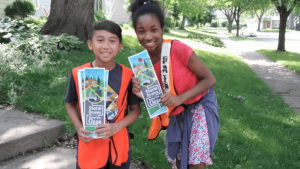While much of what we hear here about the Mississippi River revolves around proposed developments and how they will affect our access, do we know if the river’s safe to play in or fish once we get there?
The new State of the River Report 2016 answers those questions on broad and somewhat specific scales, lauds river-friendly achievements of the last four years to four decades, and raises some new concerns.
A standout in those new concerns: Microplastics. Scientists are finding very small particles, mostly synthetic fibers, in the stomachs of aquatic creatures. The long-term effects can be tumor formation, false satiation (feeling full while not getting actual nutrients), inhibited hatching and
decreasing growth rates. These fibers are like the dryer lint you see after a load of polyester-content clothing, or can come from tire wear on the highways.
Separate from this report but worth noting: The City of Minneapolis recently took dryer lint off of the list of “organic” recyclables because of similar concerns about microfibers in soil.
Already, another type of microplastic, the exfoliating beads used in rinse-off cosmetics, have been banned at the federal level. Microplastics are still allowed in sunscreen and lotion products.
The report looks at the river from Dayton and Ramsey, Minn., through the Twin Cities and south to Hastings/Prescott, the area known as the Mississippi National River and Recreation Area, MNRRA, which was designated a national park in 1988. The report was produced by the Friends of the Mississippi River and MNRRA, part of the National Park Service, which is celebrating its 100th anniversary this year.
Reports of this scale have the power to push forward helpful legislation. In the four years since the 2012 report, these strides have been made: A ban on consumer products containing triclosan, a statewide ban on coal tar sealants, and Congress’ closing of the St. Anthony Locks to stop the spread of Asian Carp.
Northeaster readers may already be familiar with many of the recommendations. For example, Minneapolis residents, through city regulations and help from Mississippi Watershed Management Organization, Metro Blooms and others, have been encouraged to keep storm water from running off their properties through rain gardens, rain barrels, pervious pavers, green roofs and natural landscape.
Flow and hydrology is one of the report’s major concerns. Higher or lower than normal (natural) flows can both drastically affect river health. Compared to natural, urban/suburban developed areas have 10 percentage points less evapotranspiration (evaporation and uptake through foliage and trees) and one and a half times more runoff (25% vs. 10%). Farms with artificial drainage are a little closer to natural, but still have almost twice the runoff (17% vs. 10%).
In addition to reinforcing the residential recommendations, the report calls for farmers to use cover crops in spring and fall, and for perennial vegetation (which re-grows year after year) to be developed or brought back. Alfalfa, for example, is a perennial. Various online sources the Northeaster researched talk about back-cross breeding to develop perennial strains of what we consider traditional crops; new harvesting methods would be needed. There are also other types of protein and carbohydrate crops that could be popularized.
Is the River safe to swim in? No, not in our area and not until you get to the south end of St. Paul, and never within 48 hours of a rainstorm anywhere along the river. Bacteria levels from excrement are in excess of safe, due to field-applied manures, pets, wildlife and human sources. The biggest concern is accidentally drinking the water…if you do swim, rinse off well afterward, and keep this in mind if you let your dog swim in the river.
The Minnesota Pollution Control Agency has completed its bacteria clean-up plans for most of the Mississippi and its tributaries in Minnesota, a link to their plan is in the bacteria section of the online report.
How are we doing on phosphorus? The river is considered “impaired” in our area, “not impaired” from the St. Anthony Falls Dams south through Minneapolis to the junction with Minnehaha Creek, and “impaired” downriver to the end of the study area.
The report highlights five key measures of the health of the river ecosystem: Fish consumption, fish survey, invasive Asian carp, bald eagles and mussels – all of which had started to improve even four years ago.
Two take-away recommendations for the public: You can help stop Asian carp by never moving bait from water to water. Help reduce lead in the environment by using non-toxic ammunition and fishing tackle, and asking bait stores to stock unleaded sinkers. (A single sinker could kill an animal that consumes it).
Some good news: In the Northeast/North Minneapolis area, the river is considered “not impaired” in terms of sediment. It will be interesting to see how those managing the re-building of Hall’s Island at the former Scherer Brothers site assess and use what they learn about how sediments flow and get deposited. Already, the river has started to return to normal now that it’s no longer being dredged for shipping, according to another study underway.
We’re also doing okay locally with regard to nitrates, chloride, and pesticides in the river. However, the report’s authors note that nationally, excess nitrogen pollution (most of which comes from cropland) remains a serious problem for the Gulf of Mexico, and Minnesota contributes the sixth highest load to the dead zone. The report calls for establishing a state nitrate standard, and for continued vigilance on these and all measures. [Just because a measure is below a set standard doesn’t mean it’s okay, it could mean the standard is wrong.]
Chlorides come mainly from de-icing salts and water softeners. The report shows a map of lakes, rivers and streams that are impaired or at high risk. One teaspoon of salt permanently pollutes five gallons of water. The MWMO has good videos on their website, mwmo.org, under “learning” select professional land care training. Or see the Minnesota Stormwater Manual that is in development on the Minnesota Pollution Control Agency site www.pca.state.mn.us. “Minnesota could reduce slip-and-fall liability for private applicators who attend smart salt trainings,” the report states.
These resources advise residents and businesses to avoid needing de-icers by shoveling early before snow gets compacted or turned to ice, and if using rock salt, to not apply it below 15 ºF when it’s no longer effective. The alternative is sand to provide traction and help melt when the sun comes out.
Additional contaminants of concern include mercury, PFOS (used in stain-resistant fabric, nonstick cookware, food packaging and fire-fighting foam) and triclosan, the antimicrobial that has been banned starting in 2017 and has been dropped by many in that industry.
The biggest category that consumers can control is pharmaceuticals. Expired or unwanted prescription and over- the-counter medications should never be disposed of down the drain. Wastewater treatment systems are not designed to remove these pollutants. Some pharmacies have take-back programs, many counties have drop-off programs specific to their residents. Here are the closest drop points:
• Brooklyn Center, Hennepin County District Court Brookdale, 6125 Shingle Creek Pkwy, Brooklyn Center, MN 55430. Hours: Mon-Thurs 9 a.m. – 9 p.m. Fri & Sat 9 a.m. – 5 p.m. Sun Noon – 5 p.m.
• Columbia Heights Police Department 825 41st Avenue NE Columbia Heights, MN 55421 763-706-8100 Hours: 8:00 a.m. to 4:30 p.m.
• Ramsey County Sheriff Patrol Station 1411 Paul Kirkwold Dr., Arden Hills, MN 55112.
The State of the River 2016 report involved more than 30 scientific advisors and was written and assembled primarily by Lark Weller for the National Park Service and Trevor Russell of Friends of the Mississippi River.
It is available online at www.stateoftheriver.com. There are two companion pieces, a Stewardship Guide for households, and a brand-new Teacher’s Guide to help teachers and students carry the lessons of the report into the classroom. And FMR’s Policy Guide (produced without involvement of the National Park Service) highlights the priority actions that leaders can take.
Below: Scene along the Mississippi River near Cottage Grove River Oaks; young pollution-preventing river stewards (Photos courtesy Friends of the Mississippi River). Eagle photo by Tom Reiter.


